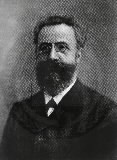
(1850-1909)
German Experimental Psychologist
Influences
- Student of:
- Influenced by: Fechner
- Students: Stern
- Influenced:
- Time Period: The Great Schools
Education
- Studied history and philology at the universities of Bonn, Halle and Berlin
- University of Bonn, Ph.D. in philosophy (1873)
- Independent post-doctoral study in England, France and Germany
Career
- Conducted his first set of memory experiments (1878-1879)
- Lecturer, University of Berlin (1880-1893)
- Conducted second set of memory experiments (1883-1884)
- Opened an experimental psychology laboratory at the University of Berlin (1886)
- Co-founder of the Zeitschrift fur Psychology und Physiologie der Sinnersorgane (Journal of Psychology and Physiology of the Sense Organs) (1890)
- Professor, University of Breslau (1894-1905)
- Founded a psychology laboratory in Breslau (1894)
- Developed a children’s intelligence test (1897)
- Professor, University of Halle (1905-1908)
Major Contributions
- Developed the first scientific approach to the study of a higher psychological process (memory)
- First person to use nonsense syllables in learning and memory research
- First to describe the “learning curve”
Ideas and Interests
In the era when Hermann Ebbinghaus began to study human memory, the study of higher psychological processes was very closely aligned with the field of philosophy; introspective self-observation approaches such as those advocated by Edward Titchener and Wilhelm Wundt dominated the field. Precise, scientific study was occurring in several psychological laboratories, but this was essentially limited to tests of physiological processes such as reaction time and sensory perception (See our profiles of Wundt and J. M. Cattell). Ebbinghaus’s systematic and careful approach to the study of memory changed this paradigm by demonstrating that higher cognitive processes could also be studied scientifically. The methodology he developed for doing this brought the study of memory out of philosophy and into the realm of empirical science. Some of his innovations, such as the use of the nonsense syllable, are still valuable tools in 21st century learning and memory research (Boneau, 1998; Wozniak, 1999).
Like his peers who used introspective methodology, Ebbinghaus used his own experiences as a source of data. However, his approach to self-study was carefully controlled; the conditions of data collection followed procedures that were commonly used in research in the so-called “hard” sciences. To test his own memory, he first created 2300 nonsense syllables, each consisting of two consonants separated by a vowel (e.g. nog, baf). These syllables were necessary for a controlled experiment because they were presumably free of any previously learned associations. He learned lists of these syllables until he had reached a pre-established criterion (perfect recall), and then recorded how many he was able to retain after specific time intervals. He also noted how many trials were necessary for relearning after the syllables had been forgotten. His first set of trials took place over the course of one year (1879-1880) and he replicated the experiments three years later. After a successful replication, he published the results in Memory: A contribution to experimental psychology (1885) (Eliasmith, 2004; Wozniak, 1999).
Ebbinghaus’s methodological innovations would have been enough to secure a place for him in the history of psychology, but his research also made several important contributions to scientific knowledge base. His experiments demonstrated empirically that meaningless stimuli are more difficult to memorize than meaningful stimuli; that is, it is harder to memorize material that does not have significance or relevance to the learner. Second, his data revealed that increasing the amount of material to be learned usually dramatically increases the amount of time it takes to learn it. This is the learning curve. Third, he established that relearning is easier than initial learning, and that it takes longer to forget material after each subsequent re-learning. Ebbinghaus’s work also suggested that learning is more effective when it is spaced out over time rather than crammed into a single marathon study session. This insight was later confirmed by other researchers (e.g. Jost, 1897) (Boneau, 1998). Finally, Ebbinghaus discovered that forgetting happens most rapidly right after learning occurs and slows down over time (Boneau, 1998; Craighead & Nemeroff, 2001). These empirical findings have important consequences for the development of pedagogical practice and also provide a theoretical basis to guide the study of individual differences in human intelligence.
Selected Publications
Ebbinghaus, H. (1885/1962). Memory: A contribution to experimental psychology. New York: Dover.
Ebbinghaus, H. (1902). Grundzüge der Psychologie. 1. Band, 2. Theil. Leipzig: Veit & Co.
Ebbinghaus, H. (1908/1973). Psychology: An elementary textbook. New York: Arno Press.
References
Boneau, C. A. (1998). Hermann Ebbinghaus: On the road to progress or down the garden path? In G. A. Kimble, & M. Wertheimer, (Eds.), Portraits of pioneers in psychology (volume 3), pp. 51-64. Mahwah, NJ: Lawrence Erlbaum.
Jost, G. (1897). Die Associationsfestigkeit in iher Abhängigkeit von der Verteilung der Wierderholungen. Zeitschriftfür Psychologie, 14, 436-472.
Wozniak, R. H. (1999). Introduction to Memory: Hermann Ebbinghaus (1885/1913). In Classics in psychology, 1855-1914: Historical essays. Bristol, UK: Thoemmes Press.
Zawidzki, T. (2004). Ebbinghaus, Hermann. In C. Eliasmith (Ed.)., Dictionary of Philosophy of Mind. Retrieved July July 24, 2006 from http://artsci.wustl.edu/~philos/MindDict/entry.html.
Image Courtesy of the National Library of Medicine
